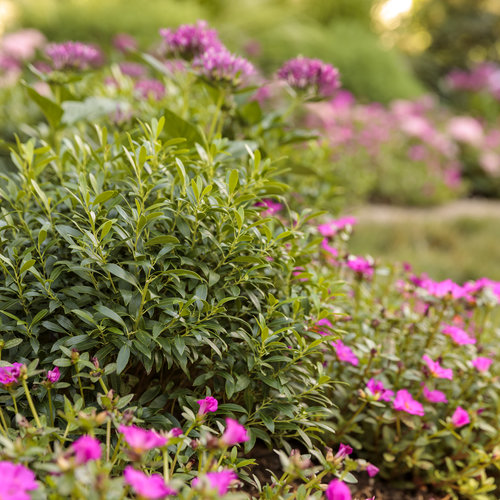

Human ingestion of berries can cause minor toxic reaction. Play Value: Attracts Pollinators Buffer Edible fruit Screening Wildlife Cover/Habitat Wildlife Food Source Wind Break Particularly Resistant To (Insects/Diseases/Other Problems): Soil compaction tolerant, deer resistant Edibility: Use caution.

This is also a cover plant for deer and other birds. Leaves are eaten by white-tailed deer and rabbits. The plant's fruits are eaten by many species of birds, including bobwhite quail and wild turkey and small mammals. Members of the genus Ilex support the following specialized bee: Colletes banksi. Other adult butterflies and bees are attracted to the blossoms as well. Adult Henry's Elfin butterflies feed on flower nectar. It is a larval host plant for Henry's Elfin (Callophrys henrici) larvae which appear from February to May and have one flight. Life Cycle: Woody Country Or Region Of Origin: Alabama Distribution: coastal plain from Nova Scotia to Florida to Louisiana Fire Risk Rating: high flammability Wildlife Value: This plant provides nectar for pollinators. Attributes: Genus: Ilex Species: glabra Family: Aquifoliaceae Uses (Ethnobotany): Dried and roasted inkberry leaves were first used by Native Americans to brew a black tea-like drink, hence the sometimes used common name of Appalachian tea for this shrub.Tags: #evergreen #drought tolerant #wildlife plant #honey bees #nectar plant #native shrub #salt tolerant #cover plant #low maintenance #winter interest #rabbit resistant #windbreak #specialized bees #food source wildlife #highly beneficial coastal plants #cpp #fire high flammability #NC native #buffer #children's garden #native garden #playground plant #edible fruits #pollinator plant #larval host plant #cover #food source fall #food source herbage #food source nectar #food source pollen #Piedmont Mountains FAC #Coastal FACW #wet soils tolerant #fruits #bird friendly #nectar plant late spring #food source soft mast fruit #butterfly friendly #nectar plant early summer #pollinator garden #bee friendly #Audubon #henry’s elfin butterfly Gem Box®, 'Nigra', 'Shamrock', Strongbox® Mounded and dense female, resistant to pests and disease good Boxwood alternative Similar to 'Shamrock', commercially available, compact See this plant in the following landscape: Entryway Garden, Cabarrus County Extension Office Cultivars / Varieties:ĭwarf female, dense and ball-shaped good Boxwood alternative Prone to Phytophthora root rot– look for resistant alternative species if this disease is in your area. Susceptible to chlorosis (yellowing of leaves) in high pH (alkaline) soils. Spider mites may appear, especially in dry conditions. Insects, Diseases, or Other Plant Problems: Habitat: Savannas, pine flatwoods, pocosin margins, swamps, primarily in wetlands, but extending upslope even into sandhills, with a clay lens or spodic horizon below to maintain additional moistureįire Risk: This plant has a high flammability rating and should not be planted within the defensible space of your home. Select plants with a low flammability rating for the sites nearest your home. It is pollinated by bees and is not self-fertile. The species is dioecious (meaning individual flowers are either male or female, but only one sex is to be found on any one plant, thus both male and female plants must be grown if seed is required). White-tailed deer may browse the leaves and twigs, although this plant is somewhat resistant to damage by deer and is rabbit resistant. in areas where beekeepers release bees from late April to early June to coincide with inkberry flowering time. This honey is locally produced in certain parts of the Southeastern U.S. The honey produced from the plant is a highly-rated honey that results from bees feeding on inkberry flowers.

Remove root suckers regularly if spread is not desired. Plants generally need minimal pruning unless used as a hedge (perhaps it is best grown as an informal hedge). Inkberry is an upright, erect, rounded, much-branched shrub that becomes open with age Prune to shape in early spring just before new growth begins. This plant is moderately salt-tolerant and adaptable to both light and heavy soils.

It is native to the coastal plain from Nova Scotia to Florida to Louisiana where it is most commonly found in sandy woods and peripheries of swamps and bogs. It typically matures to 5 to 10 feet tall, and can spread by root suckers to form colonies. Ilex glabra, commonly called inkberry or gallberry, is a slow-growing, upright-rounded, stoloniferous, broadleaf evergreen shrub in the holly family. Phonetic Spelling EYE-leks GLAY-bruh This plant has low severity poison characteristics.


 0 kommentar(er)
0 kommentar(er)
